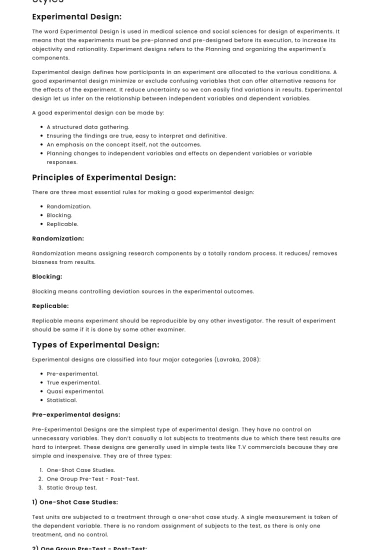Experimental Design:
The word Experimental Design is used in medical science and social sciences for design of experiments. It means that the experiments must be pre-planned and pre-designed before its execution, to increase its objectivity and rationality. Experiment designs refers to the Planning and organizing the experiment's components.
Experimental design defines how participants in an experiment are allocated to the various conditions. A good experimental design minimize or exclude confusing variables that can offer alternative reasons for the effects of the experiment. It reduce uncertainty so we can easily find variations in results. Experimental design let us infer on the relationship between independent variables and dependent variables.
Save your time!
We can take care of your essay
- Proper editing and formatting
- Free revision, title page, and bibliography
- Flexible prices and money-back guarantee
A good experimental design can be made by:
- A structured data gathering.
- Ensuring the findings are true, easy to interpret and definitive.
- An emphasis on the concept itself, not the outcomes.
- Planning changes to independent variables and effects on dependent variables or variable responses.
Principles of Experimental Design:
There are three most essential rules for making a good experimental design:
- Randomization.
- Blocking.
- Replicable.
Randomization:
Randomization means assigning research components by a totally random process. It reduces/ removes biasness from results.
Blocking:
Blocking means controlling deviation sources in the experimental outcomes.
Replicable:
Replicable means experiment should be reproducible by any other investigator. The result of experiment should be same if it is done by some other examiner.
Types of Experimental Design:
Experimental designs are classified into four major categories (Lavraka, 2008):
- Pre-experimental.
- True experimental.
- Quasi experimental.
- Statistical.
Pre-experimental designs:
Pre-Experimental Designs are the simplest type of experimental design. They have no control on unnecessary variables. They don’t casually a lot subjects to treatments due to which there test results are hard to interpret. These designs are generally used in simple tests like T.V commercials because they are simple and inexpensive. They are of three types:
- One-Shot Case Studies.
- One Group Pre-Test - Post-Test.
- Static Group test.
1) One-Shot Case Studies:
Test units are subjected to a treatment through a one-shot case study. A single measurement is taken of the dependent variable. There is no random assignment of subjects to the test, as there is only one treatment, and no control.
2) One Group Pre-Test - Post-Test:
The test unit is assessed twice with this research design, one before the test and the other after the test. There is still no control group i.e a group that does not receive the treatment.
3) Static Group test:
A Control Group is also present in Static Group design in addition to the Experimental Group. Experimental group is treated, but not to the control group. But test units are not casually allocated to the control or experimental groups.
True Experimental Designs:
True Experimental Designs is where industry investigators randomly allocate research units to treatments.
There are three major types of True experimental Designs
- Post-Test Only Control Group Design.
- Pre-Test Post-Test Control Group Design.
- Solomon Four Group Design.
1) Post-Test Only Control Group Design:
With this research design, the experimental and control groups are randomly assigned to the test units. Treatment is given to the experimental group and then both the experimental and control groups are assessed. Yet, there's only one test taken.
2) Pre-Test Post-Test Control Group Design:
Test units are randomly assigned to experimental and control groupings with this research design. Both groups are given a pre-test measure.
3) Solomon Four Group Design:
The Solomon Four Group Design is a research design that evaluates pretesting's impact on successive measures. It is used when the researcher believes earlier experiments have an effect on later test results. Test units are allotted randomly to two experimental groups and two control groups with this research design.
Quasi-experimental Designs:
Quasi-Experimental Designs can be used when an artificial system is generated by the researcher to monitor extraneous variables. The study loses control over when the procedure is delivered with quasi-experimental designs, or assigns test units non-randomly to the experimental and control groups. In Quasi Experimental Design, Randomization is missing. There are two main types of quasi-experimental designs:
- Time Series.
- Multi-Time Series.
1) Time Series:
In this type of experimental design, randomization is not present. The researcher lack control over test as well as timing.
2) Multi-Time Series:
With this design, a control group is added by the researcher. It help researcher to become able to recognize the treatment effect.
Statistical Designs:
This type of experimental design is combination of different basic experimental designs, which help researcher to analyze and control external variables with the help of statistical tools.
Bibliography
- Lavraka, P. J. (2008). Encyclopedia of Survey Research Methods.






 Stuck on your essay?
Stuck on your essay?

